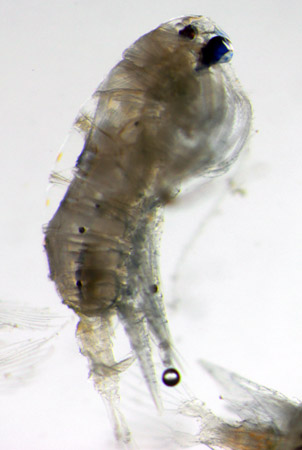Basketball Hall-of-Famer Julius Erving was known for his long-range dunks. He could jump from near the foul line and still jam the ball in the basket 15 feet away — a bit more than twice his body length. But to beat the jumping ability of some tiny marine organisms, a player would have to soar not just from the foul line, or even from the opposite end of the court — but across the length of a football field.
 One of the flying copepods that Dr. Gemmell studies. Credit: Dr. Brad Gemmell, University of Texas Marine Science Institute.
One of the flying copepods that Dr. Gemmell studies. Credit: Dr. Brad Gemmell, University of Texas Marine Science Institute.The organisms are known as copepods. They’re relatives of shrimp, but they’re only about as big as a grain of rice. They live near the surface of the water, where they’re silhouetted against the sky, making them easy-to-see targets for small fish.
But research led by Brad Gemmell of the University of Texas Marine Science Institute found that just because they’re easy to see doesn’t mean they’re easy to catch. The little critters can jump out of the water and soar up to 40 times their body length.
The researchers shot video of one species of copepod jumping out of the water to avoid predators. The jumps took them only a few inches, but that was far enough to get them out of the predator’s range of vision. The researchers also shot video of a second species in the lab, where they found that the copepods make their jumps with a single stroke of their legs.
The escape strategy uses a lot of energy just to break through the surface of the water. But once the copepod is airborne, it actually saves energy over trying to escape simply by swimming — a slam dunk for a tiny marine creature.

